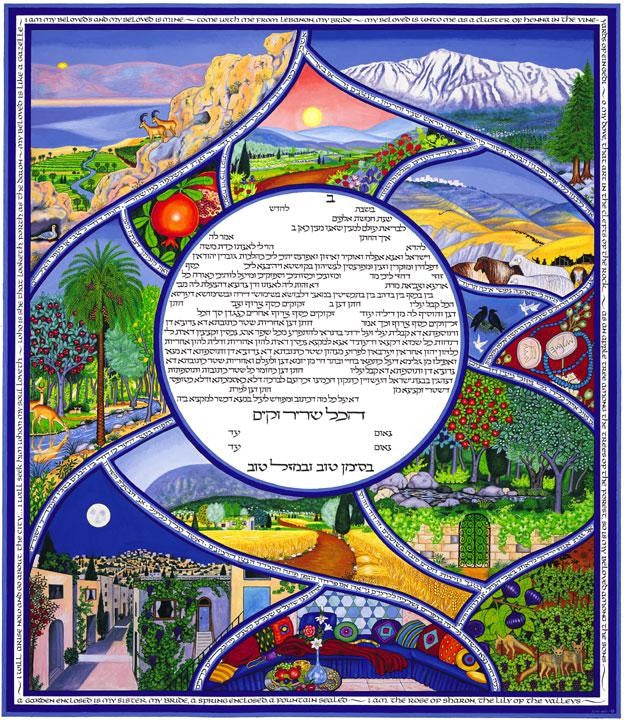
Song Of Songs
As the English writing around the Ketubah (and the Hebrew within it) indicate, this Ketubah is a "collage" of scenes and elements from that most beautiful and sensual love poetry, the Song of Songs. What I tried to do is visualize and then paint the images and metaphors that the text evokes for me, focusing mostly on the landscapes, the fauna, and the flora of Israel, my beloved home country. Below, I quote most of the verses I referred to in my painting, so that if you like, you can use them in your ceremony. The translations are from the 1917 edition of the Jewish Publication Society, with slight modifications of my own, to fit my understanding of the original Hebrew text. In the upper left part there is a scene of dawn "in the vineyards of Ein Gedi" (Song of Songs, 1:14). Above the horizon the sun is rising: "who is she that looketh forth as the dawn, fair as the moon, pure as the sun" (6:10) and on the left bottom corner is a wild dove: "O my dove, that art in the clefts of the rock, in the covert of the cliff, let me see thy countenance, let me hear thy voice" (2:14). In the upper right part is Mount Hermon: "Come with me from Lebanon, my bride [ ] from the top of Senir and Hermon" (4:8), and in the foreground are cedars: "His aspect is like Lebanon, excellent as the cedars" (5:15) and: "The beams of our houses are cedars" (1:17). In the middle between these two parts is a scene of a spring dawn in the central part of Israel, the Sharon or the Shomron: "Rise up, my love, my fair one, and come away. For, lo, the winter is past, the rain is over and gone; the flower buds appear in the land" (2:10). To the left there are pomegranates: - "Thy temple is like a pomegranate split open behind thy braid" (4:3). To the right is a scene of the hills east of Jerusalem: "Tell me, O thou whom my soul loveth, where thou feedest, where thou makest thy flock to rest at noon; for why should I be as one that veileth herself beside the flocks of thy companions? If thou know not, O thou fairest among women, go thy way forth by the footsteps of the flock and feed thy kids, beside the shepherds' tents" (1:7) Also visualized here are the verses "I am black but comely, O ye daughters of Jerusalem, as the tents of Kedar" (1:5), and "Thy hair is as a flock of goats that trail down from mount Gile'ad" (4:1). Below this scene is an image evoked by "His locks are curled, and black as the raven. His eyes are like doves" (5:11-12). Below this are two ancient personal seals (with the name Shlomo written on one of them in the Proto-Cana'anite script used in King Solomon's time): "Set me as a seal upon thy heart, as a seal upon thine arm" (8:6) and a few sprigs of the aromatic precious herb Henna: "My beloved is unto me as a cluster of Henna in the vineyards of Ein Gedi" (1:14). Below this is a scene evoked by various verses: "A garden enclosed is my sister, my bride, a spring enclosed, a fountain sealed" (4:12) and "I went down into the nut grove, to look at the green plants of the river, to see whether the grape vine blossomed and the pomegranates were in flower" (6:11). Below this to the right - "Take us the foxes, the little foxes that spoil the vineyards" (2:15), and "The fig-tree put forth her green figs" (which I "ripened" a bit). Left of this is a scene from the eastern side of Mount Carmel near my Kibbutz, evoked by three verses: "Thy head upon thee is like Carmel" (7:6); "Come, my beloved, let us go forth into the field, let us lodge in the villages" (7:12); and "Thy belly is like a heap of wheat" (7:3). Below this - "The king hath brought me into his chambers" (1:4); "My beloved unto me is like a pouch of myrrh" (1:13), and: "I am the rose of Sharon the lily of the valleys" (2:1). Left of this - "I will arise now and go about the city, in the streets and in the broad ways. I will seek him whom my soul loveth" (3:2) and also "My dove is [ ] fair as the moon" (6:9-10). And finally, above this - a scene similar to one I saw once in Jericho, alluding to a few verses: "This thy stature is like to a palm-tree." (7:9); "As an apple-tree among the trees of the forest so is my beloved among the sons, under its shadow I delighted to sit, and its fruit was sweet to my taste" (2:3); "My beloved is like a gazelle or a young hart" (2:9). The English writing around the picture begins in the upper left corner with the well-loved verse "I am my beloved's and my beloved is mine".

